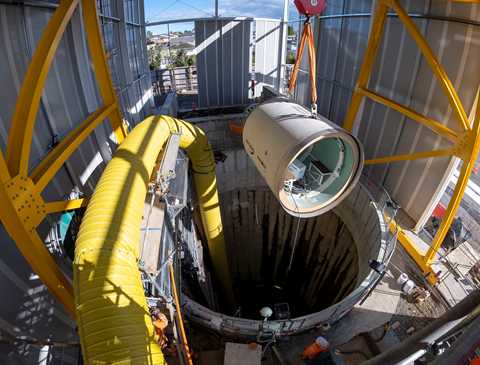A micro–Tunnel Boring Machine (mTBM) called ‘Domenica’ has started digging and laying the first pipe for Watercare’s Central Interceptor wastewater tunnel project in Auckland.
The 12-metre long mTBM laid the first three metre section of the 2.1-metre diameter pipe at the May Rd, Mount Roskill site on 4 June.
Another 328 pipe sections will follow over the next four months to create the first of two link sewers, which will branch off the main Central Interceptor Tunnel.
The mTBM will travel up to 18 metres per day. Digging will take place 24 hours a day, six days per week to complete the first drive.
Watercare chief executive officer, Jon Lamonte says laying the first pipe underground was a major milestone.
“It’s a great day for everyone on the Central Interceptor team,” he said.
“Congratulations to everyone involved in reaching this important milestone.”
An underground operator runs the mTBM, which uses a pipe-jacking method of construction. The first link sewer to be completed will travel from May Rd to Miranda Reserve in Avondale. The second will start near the Mt Albert War Memorial and travel 1.5 kilometres to the Ōrākei sewer main.
TBMs are traditionally given female names and Domenica is named after Italian relatives of Ghella, one of the partners in the Ghella Abergeldie Joint Venture, which is delivering the project. She was manufactured in Germany and refurbished in Thailand.
Once completed in 2025, the Central Interceptor will run almost 15 kilometres underground from Grey Lynn to the Māngere Wastewater Treatment Plant. The $1.2 billion project will drastically reduce wet-weather overflows in Central Auckland waterways, which occur when stormwater floods the system during heavy rain.
The main TBM, Hiwa-i-te-rangi will begin its journey digging the major tunnel from Māngere in July. She is currently lying in sections close to the shaft and is being prepared for launch. Large cranes are carefully lifting 17 gantries into place around the shaft edge, ready for the lowering operation in coming weeks.
The Central Interceptor is the largest wastewater project in New Zealand history.
Once completed, the Central Interceptor will be the longest bored tunnel in New Zealand. Providing both storage and conveyance, it will hold the equivalent of 80 Olympic-sized swimming pools and act as a buffer for the wastewater treatment plant in times of high flow.



